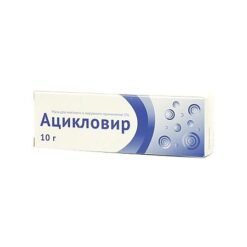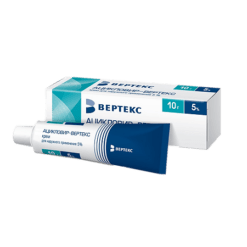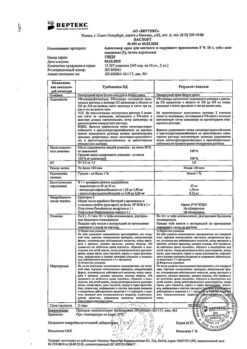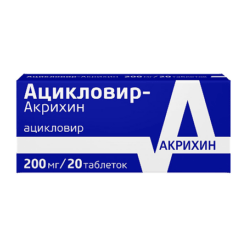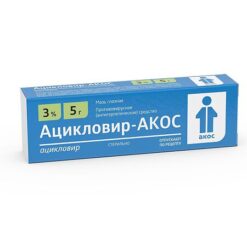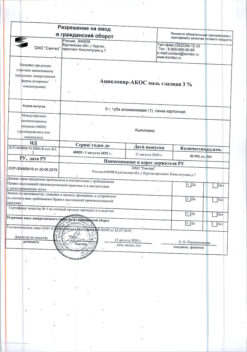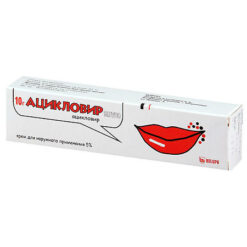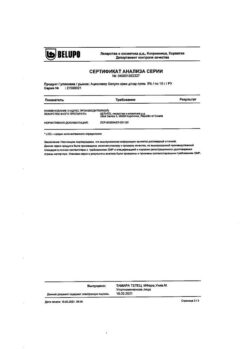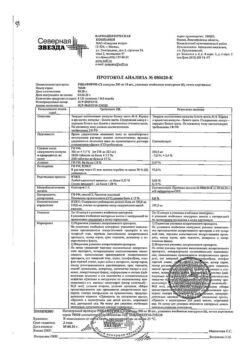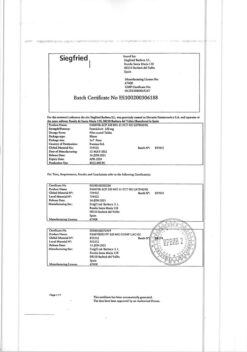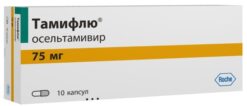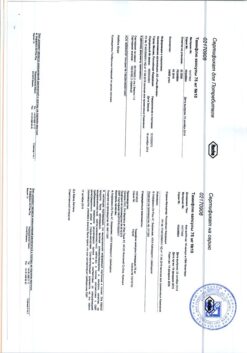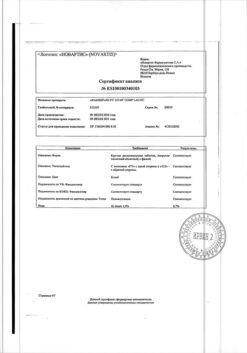No products in the cart.
Description
Pharmacotherapeutic group: antiviral drug.
ATX code: J05AB01
Pharmacological properties
Pharmacodynamics
Acyclovir is a synthetic purine nucleoside analog that has the ability to inhibit in vitro and in vivo human herpes viruses, including herpes simplex virus (HPV) types 1 and 2, varicella zoster virus (Varicella zoster virus (VZV)), Epstein-Barr virus (EBV) and cytomegalovirus (CMV). In cell culture acyclovir has the most pronounced antiviral activity against HPV-1, followed in descending order of activity by: HPV-2, VZV, EBV and CMV.
In patients with severe immunodeficiency, prolonged or repeated courses of acyclovir therapy may lead to the emergence of resistant strains, so further treatment with acyclovir may not be effective. Most isolated strains with reduced sensitivity to acyclovir showed relatively low levels of viral thymidine kinase, impaired viral thymidine kinase structure or DNA polymerase. Exposure of herpes simplex virus (HPV) strains to acyclovir in vitro can also result in the formation of less sensitive strains. No correlation has been established between the sensitivity of herpes simplex virus (HPV) strains to acyclovir in vitro and the clinical efficacy of the drug.
Pharmacokinetics
Intake
Acyclovir is only partially absorbed from the intestine. After administration of 200 mg of acyclovir every 4 hours, the mean maximum equilibrium plasma concentration (Cssmax) was 3.1 µM (0.7 µg/mg), and the mean equilibrium minimum plasma concentration (Cssmin) was 1.8 µM (0.4 µg/mL). When 400 mg and 800 mg of acyclovir were given every 4 hours, Cssmax was 5.3 µM (1.2 µg/mL) and 8 µM (1.8 µg/mL), respectively, and Cssmin was 2.7 µM (0.6 µg/mL) and 4 µM (0.9 µg/mL), respectively.
Distribution
The concentration of acyclovir in cerebrospinal fluid is approximately 50% of its concentration in plasma.
Aciclovir binds only slightly (9-33%) with plasma proteins, therefore drug interactions due to displacement from binding sites with plasma proteins are unlikely.
Elimation
In adults after oral administration of acyclovir the elimination half-life from the blood plasma is about 3 hours. Most of the drug is excreted unchanged by the kidneys. Renal clearance of acyclovir significantly exceeds creatinine clearance, which indicates excretion of acyclovir not only by glomerular filtration, but also by tubular secretion. The main metabolite of acyclovir is 9-carboxymethoxymethylguanine, which accounts for about 10-15% of the administered dose of the drug in the urine. When administering acyclovir 1 hour after taking 1 g of probenecid, the half-life of acyclovir and AUC (area under the pharmacokinetic curve “concentration-time”) increased by 18% and 40%, respectively.
Special patient groups
In patients with chronic renal failure the half-life of acyclovir averaged 19.5 hours. With hemodialysis, the average half-life of acyclovir was 5.7 hours. The plasma concentration of acyclovir decreased by approximately 60% during dialysis.
In elderly patients, acyclovir clearance decreases with age in parallel with a decrease in creatinine clearance, but the half-life of acyclovir changes only slightly.
The pharmacokinetic characteristics of both drugs were virtually unchanged when acyclovir and zidovudine were administered simultaneously to HIV-infected patients.
Indications
Indications
Treatment of skin and mucous membrane infections caused by the herpes simplex virus, including primary and recurrent genital herpes;
prevention of relapses of infections caused by the herpes simplex virus in patients with normal immune status;
prevention of infections caused by the herpes simplex virus in patients with immunodeficiency;
treatment of chickenpox and herpes zoster (early treatment of herpes zoster with acyclovir has an analgesic effect and can reduce the incidence of postherpetic neuralgia).
Pharmacological effect
Pharmacological effect
Pharmacotherapeutic group: antiviral agent.
ATX code: J05АВ01
Pharmacological properties
Pharmacodynamics
Acyclovir is a synthetic purine nucleoside analogue that has the ability to inhibit in vitro and in vivo human herpes viruses, including herpes simplex virus (HSV) types 1 and 2, varicella zoster virus (VZV), Epstein-Barr virus (EBV) and cytomegalovirus (CMV). In cell culture, acyclovir has the most pronounced antiviral activity against HSV-1, followed in descending order of activity by: HSV-2, VZV, EBV and CMV.
The inhibitory effect of acyclovir on herpes viruses (HSV-1, HSV-2, VZV, EBV and CMV) is highly selective. Acyclovir is not a substrate for the thymidine kinase enzyme in uninfected cells, therefore acyclovir is of low toxicity to mammalian cells. Thymidine kinase of cells infected with HSV, VZV, EBV and CMV viruses converts acyclovir into acyclovir monophosphate, a nucleoside analogue, which is then sequentially converted into diphosphate and triphosphate under the action of cellular enzymes. The incorporation of acyclovir triphosphate into the viral DNA chain and subsequent chain termination block further replication of the viral DNA.
In patients with severe immunodeficiency, long-term or repeated courses of acyclovir therapy may lead to the emergence of resistant strains, so further treatment with acyclovir may be ineffective. The majority of isolated strains with reduced sensitivity to acyclovir had a relatively low content of viral thymidine kinase and a disorder in the structure of the viral thymidine kinase or DNA polymerase. In vitro exposure of herpes simplex virus (HSV) strains to acyclovir may also result in the formation of strains that are less sensitive to it. A correlation has not been established between the sensitivity of herpes simplex virus (HSV) strains to acyclovir in vitro and the clinical effectiveness of the drug.
Pharmacokinetics
Suction
Acyclovir is only partially absorbed from the intestine. After administration of 200 mg of acyclovir every 4 hours, the mean maximum steady-state plasma concentration (Cssmax) was 3.1 μM (0.7 μg/mg) and the mean steady-state trough plasma concentration (Cssmin) was 1.8 μM (0.4 μg/mL). When taking 400 mg and 800 mg of acyclovir every 4 hours, Cssmax was 5.3 μM (1.2 μg/ml) and 8 μM (1.8 μg/ml), respectively, and Cssmin was 2.7 μM (0.6 μg/ml) and 4 μM (0.9 μg/ml), respectively.
Distribution
The concentration of acyclovir in cerebrospinal fluid is approximately 50% of its concentration in blood plasma.
Acyclovir binds to blood plasma proteins to an insignificant extent (9-33%), so drug interactions due to displacement from binding sites with blood plasma proteins are unlikely.
Removal
In adults, after oral administration of acyclovir, the plasma half-life is about 3 hours. Most of the drug is excreted unchanged by the kidneys. The renal clearance of acyclovir significantly exceeds the clearance of creatinine, which indicates that acyclovir is eliminated through not only glomerular filtration, but also tubular secretion. The main metabolite of acyclovir is 9-carboxymethoxymethylguanine, which accounts for about 10-15% of the administered dose of the drug in the urine. When acyclovir was administered 1 hour after taking 1 g of probenecid, the half-life of acyclovir and AUC (area under the concentration-time pharmacokinetic curve) increased by 18% and 40%, respectively.
Special patient groups
In patients with chronic renal failure, the half-life of acyclovir averaged 19.5 hours. During hemodialysis, the average half-life of acyclovir was 5.7 hours. Plasma acyclovir concentrations decreased by approximately 60% during dialysis.
In elderly patients, the clearance of acyclovir decreases with age in parallel with a decrease in creatinine clearance, but the half-life of acyclovir changes slightly.
When acyclovir and zidovudine were administered simultaneously to HIV-infected patients, the pharmacokinetic characteristics of both drugs remained virtually unchanged.
Special instructions
Special instructions
The available data from clinical trials are insufficient to conclude that the use of acyclovir reduces the risk of varicella in patients with normal immune status.
The risk of developing renal failure increases when used simultaneously with other nephrotoxic drugs.
Hydration status
Patients taking high doses of Acyclovir Renewal by mouth should receive sufficient fluids.
Elderly patients and patients with impaired renal function
Since acyclovir is excreted by the kidneys, dose adjustment of the drug is necessary in patients with impaired renal function (see section “Method of administration and dosage”).
Elderly patients may experience impaired renal function, so dose adjustment is necessary for this group of patients. Both elderly patients and patients with impaired renal function are at increased risk of developing side effects from the nervous system (such reactions are usually reversible in response to drug withdrawal) and, accordingly, should be under close medical supervision.
Patients with severe immunodeficiency
Long-term or repeated courses of treatment with acyclovir in patients with severe immunodeficiency may lead to the emergence of strains of the virus with reduced sensitivity to acyclovir that will not respond to continued therapy with acyclovir.
Transmission of infection
All patients, especially those with clinical manifestations, should exercise caution to avoid the potential for transmission of the virus, and patients should be informed about cases of asymptomatic carriage of the virus.
Impact on the ability to drive vehicles and machinery
There have been no studies of the effect of acyclovir on the ability to drive vehicles or operate machinery. It is not possible to predict the negative impact of acyclovir on these activities based on the pharmacological properties of the active substance, but it is necessary to take into account the side effect profile of acyclovir.
Active ingredient
Active ingredient
Acyclovir
Composition
Composition
Active ingredient:
acyclovir – 200.00 mg;
Excipients: lactose monohydrate, microcrystalline cellulose, sodium carboxymethyl starch, povidone K 30, magnesium stearate
Pregnancy
Pregnancy
Fertility
There is no data on the effect of acyclovir on female fertility. A study of 20 male patients with normal sperm counts found that oral acyclovir up to 1 g per day for 6 months had no clinically significant effect on sperm count, motility or morphology.
Pregnancy
The post-registration registry of pregnancies during treatment with acyclovir collected data on pregnancy outcomes in women taking acyclovir in different dosage forms. In an analysis of registry data, there was no increase in the number of birth defects in infants whose mothers took acyclovir during pregnancy compared with the general population. The identified birth defects were not uniform or consistent, suggesting a common cause.
However, caution should be exercised when prescribing acyclovir to women during pregnancy and assess the expected benefit to the mother and the possible risk to the fetus.
Breastfeeding period
After oral administration of acyclovir at a dose of 200 mg 5 times a day, acyclovir was detected in breast milk at concentrations ranging from 60 to 410% of plasma concentrations. At such concentrations in breast milk, breastfed infants can receive acyclovir in doses up to 0.3 mg/kg/day. Given this, caution should be exercised when prescribing Acyclovir Renewal to nursing women.
Contraindications
Contraindications
Hypersensitivity to acyclovir, valacyclovir or any other component of the drug; lactase deficiency, lactose intolerance, glucose-galactose malabsorption; children up to 3 years old.
With caution
Pregnancy, breastfeeding, old age, renal failure, dehydration, simultaneous use with other nephrotoxic drugs.
Side Effects
Side Effects
To assess the frequency of adverse reactions (AR), the following criteria were used: “very often” (> 1/10); “often” (≥ 1/100, < 1/10); “uncommon” (≥ 1/1000, < 1/100); “rare” (≥ 1/10000, < 1/1000); “very rare” (< 1/10000). HPs are grouped in accordance with the system-organ classes of the medical dictionary for regulatory activities MedDRA, as well as the recommendations of the World Health Organization.
From the circulatory and lymphatic system: very rarely – anemia, leukopenia, thrombocytopenia.
From the immune system: rarely – anaphylaxis.
From the central nervous system: often – headache, dizziness; very rarely – agitation, confusion, tremor, ataxia, dysarthria, hallucinations, psychotic symptoms, convulsions, drowsiness, encephalopathy, coma.
Typically, these side effects were observed in patients with renal failure or in the presence of other precipitating factors and were mainly reversible.
From the respiratory system, chest and mediastinal organs: rarely – shortness of breath.
From the digestive system: often – nausea, vomiting, diarrhea, abdominal pain.
From the liver and biliary tract: rarely – a reversible increase in bilirubin and liver enzymes in the blood; very rarely – hepatitis, jaundice.
From the skin and subcutaneous tissue: often – itching, rash, including photosensitivity; uncommon – urticaria, rapid diffuse hair loss. Since this type of alopecia is observed in various diseases and during therapy with many drugs, its connection with taking acyclovir has not been established; rarely – angioedema; very rarely – toxic epidermal necrolysis, exudative erythema multiforme.
From the urinary system: rarely – increased concentrations of urea and creatinine in the blood serum; very rarely – acute renal failure, renal colic. Renal colic may be associated with renal failure and crystalluria.
Others: often – fatigue, fever.
Interaction
Interaction
No clinically significant interactions were observed with acyclovir.
Acyclovir is excreted unchanged in the urine by active tubular secretion. All drugs with a similar route of elimination may increase plasma concentrations of acyclovir.
Acyclovir increases theophylline AUC by approximately 50% when administered concomitantly, so it is recommended that plasma theophylline concentrations be measured when acyclovir is coadministered.
Probenecid and cimetidine increase the AUC of acyclovir and reduce its renal clearance.
There was an increase in plasma AUC for acyclovir and the inactive metabolite mycophenolate mofetil, an immunosuppressant used in transplantation, when both drugs were used simultaneously.
However, no dose adjustment is required due to the broad therapeutic index of acyclovir.
Overdose
Overdose
Symptoms
Acyclovir is only partially absorbed from the gastrointestinal tract. As a rule, no toxic effects have been reported with a random single dose of acyclovir up to 20 g. With repeated oral doses over several days of doses exceeding the recommended ones, disturbances from the gastrointestinal tract (nausea, vomiting) and nervous system (headache and confusion) were observed. Sometimes neurological effects such as seizures and coma may occur.
Treatment
Patients require careful medical monitoring to identify possible symptoms of intoxication. Acyclovir is eliminated from the body by hemodialysis, so hemodialysis can be used to treat overdose.
Storage conditions
Storage conditions
At a temperature not exceeding 25 °C.
Keep out of the reach of children.
Shelf life
Shelf life
4 years.
Do not use after expiration date.
Manufacturer
Manufacturer
Update of PFC JSC, Russia
Additional information
| Shelf life | 4 years. Do not use after the expiration date. |
|---|---|
| Conditions of storage | At a temperature not higher than 25 ° C. Keep out of reach of children. |
| Manufacturer | Update PFC AO, Russia |
| Medication form | pills |
| Brand | Update PFC AO |
Other forms…
Related products
Buy Aciclovir Reneval, tablets 200 mg 20 pcs with delivery to USA, UK, Europe and over 120 other countries.


